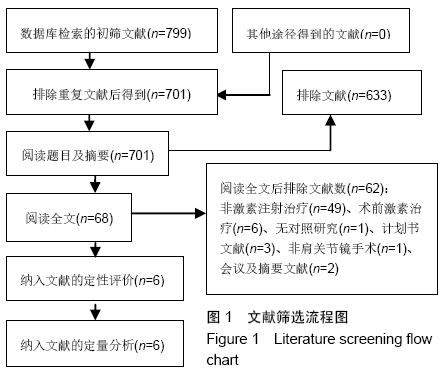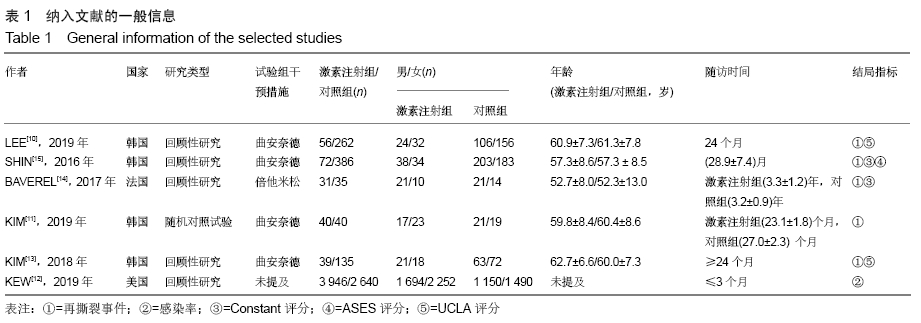中国组织工程研究 ›› 2020, Vol. 24 ›› Issue (24): 3931-3936.doi: 10.3969/j.issn.2095-4344.2715
• 骨与关节循证医学 evidence-based medicine of the bone and joint • 上一篇
肩关节镜术后关节腔内注射皮质类固醇激素安全性的系统评价与Meta分析
范智荣1,苏海涛2,江 涛2,周俊德1,彭嘉杰1,洪伟武1,周 霖1,黄晖达1
- 1广州中医药大学第二临床医学院,广东省广州市 510405;2广州中医药大学第二附属医院骨科,广东省广州市 510006
Safety of intraarticular corticosteroid injections after arthroscopic shoulder surgery: a systematic review and meta-analysis
Fan Zhirong1, Su Haitao2, Jiang Tao2, Zhou Junde1, Peng Jiajie1, Hong Weiwu1, Zhou Lin1, Huang Huida1
- 1Second Clinical Medical College, Guangzhou University of Chinese Medicine, Guangzhou 510405, Guangdong Province, China; 2Department of Orthopedics, Second Affiliated Hospital of Guangzhou University of Chinese Medicine, Guangzhou 510006, Guangdong Province, China
摘要:

文题释义:
肩关节镜:随着肩关节镜手术适应证的扩大及手术技术和器械的不断更新发展,在过去20年间肩关节镜手术越来越普遍。肩关节镜手术是临床诊断肩袖撕裂、撞击综合征和不稳定性、SLAP损伤、Bankart损伤等疾病的主要诊断和治疗工具。
皮质类固醇激素:关节内注射皮质类固醇激素是一种有效缓解术后肩部疼痛和僵硬的方法之一,因为其可以减少滑膜炎症,减轻疼痛感并加速术后早期功能恢复。然而人们仍然担心使用皮质类固醇激素是否会增加肩关节镜术后相关并发症,例如术后感染、术后早期肌腱断裂、延缓肌腱愈合等,其安全性及临床疗效尚存争议。
背景:肩关节镜术后关节内注射皮质类固醇激素是一种有效缓解术后肩部疼痛和僵硬的方法之一,但使用皮质类固醇激素是否会增加肩关节镜术后相关并发症仍有争议。
目的:系统评价肩关节镜术后关节腔内注射皮质类固醇激素的安全性及临床疗效。
方法:应用计算机检索PubMed、EMBASE、Cochrane Central Register of Controlled Trials(CENTRAL)数据库中肩关节镜术后关节腔内注射皮质类固醇激素的临床对照试验,检索时间为建库至2019年9月。文献数据提取及质量评价由2位研究者按照纳入和排除标准独立进行,采用Rev man 5.3 版本软件进行效应量的合并与分析。
结果与结论:①共纳入6篇相关文献,包括7 418例患者,其中激素注射组3 920例、对照组3 498例;②Meta分析显示,两组再撕裂率、Constant评分、ASES评分、UCLA评分比较差异均无显著性意义[OR=0.71,95%CI[0.45,1.13],P=0.15;MD=-0.99,95%CI(-12.44,10.46),P=0.87;MD=-0.12,95%CI (−1.80,1.56),P=0.89;MD=−1.46,95%CI(−3.22,0.30),P=0.10];激素注射组肩关节镜术后1个月内感染率高于对照组(P < 0.05),两组肩关节镜术后2-4个月的感染率比较差异无显著性意义(P > 0.05);③结果表明,肩关节镜术后注射皮质类固醇激素并不会增加术后再撕裂率,但肩关节镜术后1个月内注射类固醇激素会增加术后感染率,因此在肩关节镜术后应用皮质类固醇激素治疗时,临床医师应根据患者实际情况权衡利弊,同时注意避免在术后1个月内注射关节内激素治疗。
ORCID: 0000-0002-5259-5160(范智荣)
中国组织工程研究杂志出版内容重点:人工关节;骨植入物;脊柱;骨折;内固定;数字化骨科;组织工程
中图分类号:






